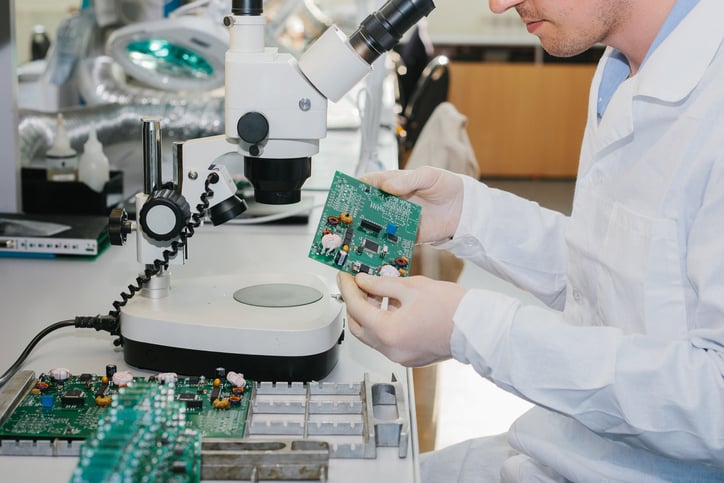Guide to Working With an Electronics Manufacturing Services Company
“How will my idea go from conception to finished product at your company?” It’s a question we hear a lot, and a good one. It’s natural to want to...

A report in 2020 estimated that one in every 10 vehicles globally will be self-driving by 2030. Driverless cars come with several benefits, including improved business efficiencies and reduced road crashes, emissions, and congestion.
Notably, driverless car sensor technologies have undergone several changes in recent times thanks to innovation in printed circuit board (PCB) devices. PCBs play an integral role in the automotive industry, and innovations in PCB designs for autonomous vehicles electronics have changed the way manufacturers make autonomous vehicles.
During the manufacture of autonomous vehicles, a PCB manufacturer does everything from the initial prototype to testing vehicle construction, but it's on you to "help them help you." If your design team works on electronics for autonomous cars, you need to acquaint yourself with the following best practices for autonomous vehicle PCBs:
Understanding the best practices in electronics circuit design and how to apply them to your specific application is crucial when producing any product.
Let’s focus on the following golden areas in PCB design ...
… and some bonus considerations!
Automotive PCBs devices should be robust enough to survive harsher environments than the PCBs typically used in other applications. Automotive PCBs are typically exposed to:
A strong device withstands all these elements without failing. During your designs, ensure the PCB materials and enclosures pass thermal reliability and long-term tests typical of harsher environments.
For a substrate, you can go with alumina or aluminum nitride ceramic substrates when designing PCBs for the engine compartment. You may also opt for heavy copper PCBs when looking for boards that must withstand higher currents and higher temperatures in charging, power distribution, and power management systems.
In recent times, the autonomous vehicle industry has witnessed greater integration of what used to be distinct, diverse systems. You can achieve greater processing power in vehicles by prioritizing PCB design integration among sensors, electronic control units, and several electromechanical systems controlling all aspects of an autonomous vehicle.
Be aware that software complexities keep increasing alongside the need for massive amounts of data for:
Achieving greater integration within a limited design space requires a level of miniaturization at the board, component, and interconnect level. Even as you try to achieve so much in little space, ensure all crucial systems are adequately protected from elements, humidity, and mechanical vibration.
An autonomous vehicle should boast exceptional capabilities that exceed that of human drivers. That’s the point, right?
When designing PCBs for driverless electronics, aim for a detection system that combines various sensors and computing. To achieve this, you need to leverage different sensor types, redundancy, and overlapping sensors that enhance your car's vision accuracy.
The most crucial autonomous vehicle sensors include:
Your sensors should use technology fusion electronics to provide the car with surrounding visual maps that detect the shape, speed, and distance of objects.
When designing Lidar systems for autonomous vehicles, don’t underestimate the importance of the cooling mechanism, airflow, and surrounding temperature.
Lidar systems usually live on vehicle roofs and other applications exposed directly to the sun. The distance an autonomous vehicle's Lidar system can measure is affected by its thermal heat. Notably, the Lidar systems that integrate custom systems-on-chip (socs) integrated circuits (ICs) may have their operating temperatures and external surfaces influenced by their internal heat generation.
Ensure your designs meet all safety requirements by carrying out thermal simulation and analysis to help you detect any thermal issues before production. Thermal simulation and analysis will not only shorten your overall design process, but will also help you achieve a more robust product design that meets certification requirements.
Good thermal management of PCBs and all essential ICs on the board guarantees reliability and performance. When designing PCBs for Lidar, keep in mind that internal Lidar components produce heat that can be convected, conducted, and radiated across all internal surfaces.
Consider adding new heat conduction paths to achieve a higher heat transfer effectiveness. You can also factor in a heat sink on your design that helps lower component temperatures.
Testing autonomous vehicle electronics for functionality in scorching and cold weather conditions is also critical for engineers to make important design decisions. It's a good practice to conduct simulation-driven analysis in early prototyping to get insights and account for the myriad performance and life-limiting factors in your design.
To meet the standard safety specifications for autonomous vehicles, PCB designs for self-driving electronic systems should ensure a transition from fail-safe/fail-silent to fail-operating mode.
For electronics in driverless cars, consider a two-channel architecture for electronic control units handling safety-critical functions. Due to the integration of diverse components and automated features, it's crucial to ensure robust interoperability within the vehicle. For an autonomous car to function as intended, the devices and components should exchange, share, and interpret data seamlessly.
Here are some other electronics design guide and tips that apply to virtually all PCB designs, but shouldn’t be forgotten:
Ensure you keep components at a safe distance from the edge. When you put capacitors too close to the edge, you increase the risk of damage.
Factor in a route around any parts near the edge of the PCB board design.
Having fewer components comes with several benefits, including streamlined:
A lean design means fewer costs all around.
Avoid RoHS-compliant hot air solder leveling, as it's not ideal for finishes on these parts.
You can opt for electroless nickel immersion gold (ENIG), which is practical and cost-friendly. ENIG finishes are much easier to solder owing to their flat nature.
Shorten your lead times by involving your automotive PCB manufacturers early in your PCB designs. The vendor can spot issues that you may miss and which can later affect certification approvals.
There's a lot of research and development happening worldwide so we can all work together to produce safer and more reliable autonomous vehicle designs. When designing PCBs for driverless truck or car electronics, the data analysis, and testing must be 100% spot-on.
To learn more about best practices for testing and prototyping an electronics project, check out our free e-book below:

“How will my idea go from conception to finished product at your company?” It’s a question we hear a lot, and a good one. It’s natural to want to...

International Traffic and Arms Regulation (ITAR) came about in 1976 because of a need to control the export of military equipment and related ...

When talking with salespeople, design engineers, and other contacts within an electronic contract manufacturer, you may hear a lot of terms thrown...